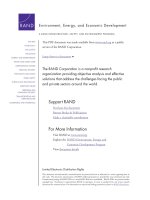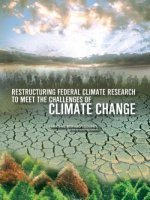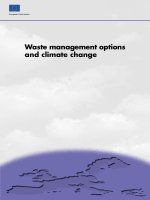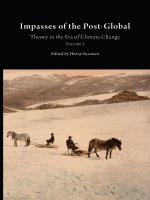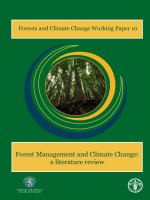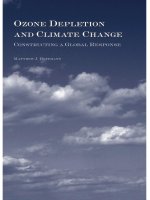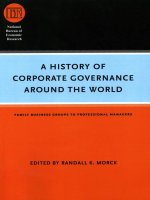Presenting Uncertainty About Climate Change to Water-Resource Managers potx
Bạn đang xem bản rút gọn của tài liệu. Xem và tải ngay bản đầy đủ của tài liệu tại đây (756.71 KB, 102 trang )
This document and trademark(s) contained herein are protected by law as indicated in a notice appearing later in
this work. This electronic representation of RAND intellectual property is provided for non-commercial use only.
Unauthorized posting of RAND PDFs to a non-RAND Web site is prohibited. RAND PDFs are protected under
copyright law. Permission is required from RAND to reproduce, or reuse in another form, any of our research
documents for commercial use. For information on reprint and linking permissions, please see RAND Permissions.
Limited Electronic Distribution Rights
This PDF document was made available from www.rand.org as a public
service of the RAND Corporation.
6
Jump down to document
THE ARTS
CHILD POLICY
CIVIL JUSTICE
EDUCATION
ENERGY AND ENVIRONMENT
HEALTH AND HEALTH CARE
INTERNATIONAL AFFAIRS
NATIONAL SECURITY
POPULATION AND AGING
PUBLIC SAFETY
SCIENCE AND TECHNOLOGY
SUBSTANCE ABUSE
TERRORISM AND
HOMELAND SECURITY
TRANSPORTATION AND
INFRASTRUCTURE
WORKFORCE AND WORKPLACE
The RAND Corporation is a nonprofit research
organization providing objective analysis and effective
solutions that address the challenges facing the public
and private sectors around the world.
Visit RAND at www.rand.org
Explore the RAND Environment, Energy, and
Economic Development Program
View document details
For More Information
A RAND INFRASTRUCTURE, SAFETY, AND ENVIRONMENT PROGRAM
Environment, Energy, and Economic Development
Purchase this document
Browse Books & Publications
Make a charitable contribution
Support RAND
This product is part of the RAND Corporation technical report series. Reports may
include research findings on a specific topic that is limited in scope; present discus-
sions of the methodology employed in research; provide literature reviews, survey
instruments, modeling exercises, guidelines for practitioners and research profes-
sionals, and supporting documentation; or deliver preliminary findings. All RAND
reports undergo rigorous peer review to ensure that they meet high standards for re-
search quality and objectivity.
Presenting Uncertainty
About Climate Change to
Water-Resource Managers
A Summary of Workshops with the
Inland Empire Utilities Agency
David G. Groves, Debra Knopman, Robert J. Lempert,
Sandra H. Berry, Lynne Wainfan
Sponsored by the National Science Foundation
A RAND INFRASTRUCTURE, SAFETY, AND ENVIRONMENT PROGRAM
Environment, Energy, and Economic Development
The RAND Corporation is a nonprofit research organization providing objective analysis
and effective solutions that address the challenges facing the public and private sectors
around the world. RAND’s publications do not necessarily reflect the opinions of its
research clients and sponsors.
R
®
is a registered trademark.
© Copyright 2008 RAND Corporation
All rights reserved. No part of this book may be reproduced in any form by any electronic or
mechanical means (including photocopying, recording, or information storage and retrieval)
without permission in writing from RAND.
Published 2008 by the RAND Corporation
1776 Main Street, P.O. Box 2138, Santa Monica, CA 90407-2138
1200 South Hayes Street, Arlington, VA 22202-5050
4570 Fifth Avenue, Suite 600, Pittsburgh, PA 15213-2665
RAND URL:
To order RAND documents or to obtain additional information, contact
Distribution Services: Telephone: (310) 451-7002;
Fax: (310) 451-6915; Email:
The research described in this report was sponsored by the National Science Foundation and
was conducted under the auspices of the Environment, Energy, and Economic Development
Program (EEED) within RAND Infrastructure, Safety, and Environment (ISE).
Library of Congress Cataloging-in-Publication Data
Presenting uncertainty about climate change to water-resource managers : a summary of workshops with the
Inland Empire Utilities Agency / David G. Groves [et al.].
p. cm.
Includes bibliographical references.
ISBN 978-0-8330-4398-6 (pbk. : alk. paper)
1. Water-supply—California—Management. 2. Climatic changes—Environmental aspects.
I. Groves, David G.
TD227.S3C35 2008
363.6'1—dc22
2007052716
iii
Preface
Water-resource managers are accustomed to planning and operating water facilities under
conditions of uncertainty about future hydrology, weather forecasts, available water supply,
and projected water demand. Weather is naturally variable on all time scales, and persis-
tent periods of drought and wetter weather are common. In the past decade or so, another
dimension of uncertainty has been added as scientists have been documenting evidence of
longer-term global climate change that is likely to persist for more than a century. Whatever
its causes, global climate change—a trend beyond the usual variability seen in the weather—
is occurring now, albeit with uncertain local consequences. Water-resource managers will
need to determine how to cope with it along with other natural and anthropogenic changes
as they revise their planning in the coming years.
is report documents a series of three workshops conducted by RAND with the Inland
Empire Utilities Agency (IEUA) in southern California in fall 2006. About 40 individuals
from IEUA and cooperating agencies and organizations participated in one or more of the
workshops. e purpose of the workshops was to explore how different descriptions of uncer-
tainty about the effects of climate change and other key factors on IEUA’s projected supply and
demand might influence water managers’ perceptions of risk and preferences for new infra-
structure investments, changes in operational policies, and adoption of regulatory measures.
To support the workshops, we developed a water-management model (WMM) with the assis-
tance of IEUA staff members and other collaborators. is model continues to be refined and
developed as a part of this on-going project. e intended audience for this report are water
managers, state and local officials, and water-resource analysts who are seeking insights into
how global climate change may call into question well-established planning assumptions and
influence future plans.
is study represents one part of a larger project, “Improving Decisions in a Complex
and Changing World,” a larger multiyear effort funded by the National Science Foundation
under the climate-change decisionmaking under uncertainty (DMUU) component of the
agency’s Human and Social Dynamics (HSD) priority area. e RAND DMUU project aims
to conduct basic research to improve computer-based tools that support decisionmaking under
conditions of deep uncertainty; examine the best means of representing uncertain scientific
information to individuals and groups so they can act on it more effectively; and strengthen
the scientific foundations of robust decisionmaking (RDM), a new approach to decision sup-
port under deep uncertainty.
iv Presenting Uncertainty About Climate Change to Water-Resource Managers
The RAND Environment, Energy, and Economic Development Program
is research was conducted under the auspices of the Environment, Energy, and Economic
Development Program (EEED) within RAND Infrastructure, Safety, and Environment (ISE).
e mission of ISE is to improve the development, operation, use, and protection of society’s
essential physical assets and natural resources and to enhance the related social assets of safety
and security of individuals in transit and in their workplaces and communities. e EEED
research portfolio addresses environmental quality and regulation, energy resources and sys-
tems, water resources and systems, climate, natural hazards and disasters, and economic devel-
opment—both domestically and internationally. EEED research is conducted for government,
foundations, and the private sector.
Questions or comments about this report should be sent to the project leader, Robert
Lempert (). Information about the Environment, Energy, and Eco-
nomic Development Program is available online ( Inquiries
about EEED projects should be sent to the following address:
Michael Toman, Director
Environment, Energy, and Economic Development Program, ISE
RAND Corporation
1200 South Hayes Street
Arlington, VA 22202-5050
703-413-1100, x5189
v
Contents
Preface iii
Figures
vii
Tables
ix
Summary
xi
Acknowledgments
xvii
Abbreviations
xix
CHAPTER ONE
Introduction 1
Purpose of the Study
1
Overview of Study Approach
2
Organization of is Report
3
CHAPTER TWO
Alternative Treatments of Uncertainty 5
Characterization of Uncertainty for Long-Term Planning
6
Workshop Design Patterned on Laboratory Experiments
7
CHAPTER THREE
Modeling Climate-Change Effects on the Inland Empire Utilities Agency 9
Hydrologic Features of IEUA’s Service Area
9
IEUA’s Sources of Supply
10
Water Management in IEUA
11
IEUA’s Long-Term Water-Management Plans
12
Potential Effects of Climate Change on IEUA Water Management
13
Water-Management Model Overview
14
WEAP Model Representation
14
Major WEAP Model Elements
16
Catchments
17
Rivers
18
Groundwater Basins
19
Irrigation Demand
19
Indoor Demand
21
Supplies
21
Chino Basin Conjunctive Use
22
Dry-Year Yield Program
23
vi Presenting Uncertainty About Climate Change to Water-Resource Managers
Unused Supply 23
Allocation of Supply to Meet Demand
24
Monthly Weather Projections
24
Performance Metrics
28
IEUA’s Existing and Potential Management Actions
29
Model Calibration and Sensitivity to Planning-Document Assumptions
31
Uncertainty About Future Management Conditions
37
CHAPTER FOUR
Performance of Inland Empire Utilities Agency Plans Under Future Conditions 39
Traditional Scenarios
39
Probability-Weighted Scenarios
44
Policy-Relevant Scenarios
47
CHAPTER FIVE
Evaluating Uncertainty Frameworks in Workshops 55
Study Design
55
Overview of Workshop Participation
56
Measuring the Effect of Decision Tools on Decisionmaking: Review of the Literature
58
System Analysis
58
Management Risk Taking
58
Results
59
Perceptions of Climate Change
59
Preferences for Presentations of Uncertainty
63
Managing Risk
65
Value of Modeling
67
Observations
70
CHAPTER SIX
Final Observations and Discussion 73
WEAP Modeling Environment
73
e Effect of Climate Change on IEUA Water Management
73
Views of Performance Under Different Types of Scenario Analysis
74
Workshop Results
75
Attitudes About Climate Change
75
Comparison Among Presentations of Uncertainties
75
Attitudes About Responsibility for Long-Term Planning
75
Attitudes About Modeling
75
Preferences for Strategies
75
References
77
vii
Figures
3.1. Boundary Map of the IEUA Service Area 10
3.2. Sources of Urban Supply for the IEUA Service Area, 2005
11
3.3. Changes in Key Supplies Over Time Under the Pre-2000 Plan and the 2005
UWMP
13
3.4. Schematic of Modeling Framework
14
3.5. RAND-IEUA WEAP Model Schematic
15
3.6. Simple Schematic of WEAP Soil-Moisture Model
20
3.7. Annual Historical Precipitation and Temperature Near Ontario, California
25
3.8. Cumulative Distribution Functions of Change in Summer Temperature from
2000 to 2010, 2020, 2030, and 2060
27
3.9. Cumulative Distribution Functions of Change in Winter Precipitation from 2000
to 2010, 2020, 2030, and 2060
27
3.10. Representative Time Series of Precipitation for Dry and Wet Climate-Change
Deciles
28
3.11. WMM-Projected Demand Under Historical Weather Conditions and the 2005
UWMP and IEUA RUWMP Demand Forecast
31
3.12. WMM-Projected Chino Basin Storage Under Historical Weather Conditions and
the 2005 UWMP
32
3.13. WMM-Projected Available Imports Under Historical Weather Conditions and the
2005 UWMP and the Average-Year Metropolitan Imports Specified in the IEUA
RUWMP
32
3.14. Supply and Demand for the 2005 UWMP, Assuming a Repeat of 1980–2003
Weather
33
3.15. Supply and Demand for the Pre-2000 Plan, Assuming a Repeat of 1980–2003
Weather
35
3.16. Shortage Exceedance Plot for the Pre-2000 Plan, Assuming a Repeat of 1980–2003
Weather
35
3.17. Shortage Exceedance Plot for Variants on the 2005 UWMP Under Historical
Climate
36
3.18. Workshop-Participant Assessments of the Achieved Level of Recycled-Water Use
and Annual Chino Basin Replenishment in 2025
36
3.19. Annual Recycling Use and GW Replenishment Under ree Levels of Goal
Achievement
38
4.1. Delivered Supply, Surplus, and Shortages for the Slightly Warmer, Meet Goals
Scenario Under the 2005 UWMP
41
4.2. Delivered Supply, Surplus, and Shortages for the Slightly Warmer, Miss Goals
Scenario Under the 2005 UWMP
42
viii Presenting Uncertainty About Climate Change to Water-Resource Managers
4.3. Delivered Supply, Surplus, and Shortages for the Hotter and Drier, Meet Goals
Scenario Under the 2005 UWMP
42
4.4. Delivered Supply, Surplus, and Shortages for the Hotter and Drier, Miss Goals
Scenario Under the 2005 UWMP
43
4.5. Relative Weights Applied to Numbered Weather Sequences for Winter
Precipitation and Summer Temperature
45
4.6. Shortage Exceedance Plots for the Four Water-Management Plans Based on 810
Probabilistically Weighted Simulations
47
4.7. Four Responses of Imports to Climate-Change Decile
48
4.8. Frequency Histogram of Average Surplus for Plan A
49
4.9. Parameter Ranges Specifying the Dry, Flashy, Low-Recycling Scenario
51
4.10. Frequency Histogram of Average Surplus for Plan A Under All Modeled Conditions
and ose Consistent with the Dry, Flashy, Low-Recycling Scenario
51
4.11. Parameter Ranges Specifying the Wet, Effective-Recycling Scenario
52
4.12. Representation of Optimal Plan Choices Under Different Subjective Assessments
of the Likelihoods of Future Conditions Being Consistent with the Dry, Flashy,
Low-Recycling Scenario, Assuming a Desired Surplus of 20 taf
54
5.1. Responses to Statement “Climate change is a very slow process that occurs over
thousands of years.”
60
5.2. Responses to Statement: “Substantial climate changes over a period of 5–10 years
are very possible.”
61
5.3. Responses to Statement: “We are likely to have plenty of notice that climate change
is happening.”
61
5.4. Responses to Statement: “Climate change may be upon us before we know it is
happening.”
62
5.5. Participants’ Perceptions of Responsibility for the Future
62
5.6. Participants’ Responses to Statement: “ere are things we can and should do
despite an incomplete understanding about the effects of climate change.”
64
5.7. Comparison of Approaches to Presenting Scenarios After Workshop 3: Responses
to the Statement: “Provides results that can be used in planning.”
64
5.8. Participants’ Responses to Usefulness of Quantitative Modeling
68
ix
Tables
3.1. Catchments in the RAND-IEUA Water-Management Model 17
3.2. Land-Use Projections for the Lower and Mid-Basin Under Base-Case Assumptions
18
3.3. Land-Use and Irrigation Parameters Used for Major Catchments
20
3.4. Projected Rates of Chino Basin Replenishment by Water Source
23
3.5. Demand Priorities in the Water-Management Model
24
3.6. Management Actions Represented in the Water-Management Model
30
3.7. Model Parameters Defining Specific Management Plans Considered in Analysis
30
3.8. Management Conditions Used to Demonstrate Performance of the Water-
Management Model and Illustrate Importance of Management Actions
34
3.9. Management Strategies Used to Demonstrate Performance of the Water-
Management Model and Illustrate Importance of Management Actions
34
4.1. Parameters Associated with Two Climate Sequences
40
4.2. Parameters Associated with the Two Levels of IEUA RUWMP Goal Achievement
40
4.3. Scenarios Used for Traditional Scenario Analysis
40
4.4. Management Strategies Evaluated in Traditional Scenario Analysis
41
4.5. Years with Shortages for Four Management Plans Under Four Scenarios
43
4.6. Average Surplus for Four Management Plans Under Four Scenarios
44
4.7. Relative Probability of Missing, Meeting, or Exceeding the IEUA RUWMP
Recycling and Replenishment Goals
46
4.8. Performance of Four Management Plans Under Probability-Weighted Scenarios
46
4.9. Uncertain Parameters and Value Ranges Used to Generate Ensemble of
Simulations for Policy-Relevant Scenario Analysis
49
4.10. Average Surplus for Four Management Plans Under the ree Policy-Relevant
Scenarios
52
5.1. Overall Presentation Structure for the RAND-IEUA Workshops
56
5.2. Summary of Workshop Attendees Who Provided Data
57
5.3. Scales for Measuring Management Risk Taking
65
5.4. Scales for Measuring Preferences for Risk-Reducing Measures
67
xi
Summary
Water-resource managers have long strived to meet their goals of system reliability and envi-
ronmental protection in the face of many uncertainties, including demographic and economic
forecasts, intrinsic weather variability, and short-term climate change induced by El Niño
and other naturally occurring cycles. Now water managers also face a new uncertainty—the
potential for longer-term and more persistent climate change, which, in coming years, may
significantly affect the availability of supply and patterns of water demand. Information about
the future effects of climate change is deeply uncertain and likely to remain so for the foresee-
able future. us, the scientific community is debating how to most usefully characterize this
important yet uncertain information for decisionmakers.
RAND is conducting a large, multiyear study under a grant from the National Science
Foundation (NSF) on climate-change decisionmaking under uncertainty (see ISE, 2007). As
part of this project, we are working with water agencies in California to help them better
understand how climate change might affect their systems and what actions, if any, they need
to take to address this challenge. As a key component of this effort, RAND has conducted
three workshops in cooperation with the Inland Empire Utilities Agency (IEUA), whose ser-
vice area overlies southern California’s Chino groundwater (GW) basin. In this report, we
document our methods and observations to preserve an archive of the workshop process and
provide a basis for refining our approach for future applications.
Purpose and Scope of IEUA Workshops
e IEUA region has already begun implementing many of the water-management strategies
described in IEUA’s 2005 Regional Urban Water Management Plan (RUWMP) (IEUA, 2005).
is plan includes a description of some of the analysis that California’s Department of Water
Resources (DWR) and Metropolitan Water District of Southern California (Metropolitan)
conducted related to the effect of global climate change on imported water supplies available
to IEUA. However, this information did not provide IEUA with a systematic assessment of the
potential effects of future climate change on its service area and the actions that the region’s
cities and agencies might take to address these changes.
e purpose of the RAND-IEUA workshops was three-fold:
Develop and exercise a new planning model for IEUA that enables consideration of the t
effects of large uncertainties on future system performance.
xii Presenting Uncertainty About Climate Change to Water-Resource Managers
Provide IEUA with state-of-the-art estimates of future climate change for its service t
area.
Measure and assess decisionmakers’ preferences among three different representations of t
key uncertainties and these uncertainties’ effect on water-resource system performance.
Working in close consultation with IEUA staff and other water agencies, the project team
developed a computer simulation model to estimate the performance of the IEUA RUWMP
and potential modifications over a wide variety of scenarios that include different future cli-
mates as well as different levels of achievement of critical recycling and replenishment goals
in the IEUA RUWMP. Over the course of three workshops (September 28, October 20, and
November 3, 2006), the project team helped officials, technical staff, other water managers
and planners, and other participants from the IEUA region to consider the significance of
potential climate change relative to a few other key uncertainties and how planners might
respond by reducing the vulnerability of supply disruptions under some scenarios. e RAND
project team presented three different characterizations of uncertainty and administered sur-
veys to workshop participants before, during, and after each of the workshops to record their
views about the effectiveness and implications of the different presentations.
e first workshop characterized what is known about future climate change and then
demonstrated differences in the performance of the IEUA RUWMP and variants (IEUA,
2005), based on assumptions that the current climate would continue into the future. In this
first workshop, the RAND team presented climate and other uncertainties using a traditional
scenario approach in which planners examined a small set of future conditions without assign-
ing any likelihood or probability to their occurrence. In the second workshop, we presented
state-of-the-art, probabilistic scenarios of climate change and then used these distributions
to estimate the expected performance of the IEUA RUWMP and variants. Finally, in the
third workshop, we presented a new approach, RDM, to develop policy-relevant scenarios,
which were analytically derived from an extensive examination of many future conditions. We
intended these scenarios to help IEUA consider ways in which it might augment its plans to
reduce its vulnerability to potentially stressful future conditions.
Different Analyses of IEUA System Performance
e water-modeling analysis developed for this project not only offered the material for evalu-
ating different presentations of uncertainty; it also provided useful information to IEUA and
other regional water managers.
e traditional scenario analysis demonstrated that current plans would perform well
if future climate were benign, that is, wetter than historic conditions, even with incomplete
implementation of IEUA’s recycling and replenishment goals. If the future climate were adverse,
that is, drier and warmer than historic conditions, IEUA would need to meet its recycling and
replenishment goals, as well as invest in more efficiency, and possibly allow more recycled-GW
replenishment to ensure sufficient supply to meet demand. ese traditional scenarios can
provide a simple description of a range of future conditions relevant to IEUA. But such sce-
nario analyses can also fall short of decisionmakers’ needs because the choice of scenarios can
appear arbitrary and the approach provides no systematic means to compare alternative policy
choices.
Summary xiii
e probability-weighted scenarios suggest that, if one believed the best-available proba-
bilistic information about both future climate and the IEUA region’s ability to meet the agen-
cy’s recycling and replenishment goals, the IEUA RUWMP can ensure that the chance of a
shortage over the next 25 years will not exceed 7 percent. Probabilistic scenarios can provide
a concise ranking of the desirability of alternative IEUA plans but can lead to errors of omis-
sion in planning by downplaying the potential importance of possible futures that deviate from
likeliest conditions. Further, effective use of probabilistic scenarios may require a wide range of
stakeholders to agree on the validity of the distributions used in the analysis.
e policy-relevant scenarios identified two sets of conditions potentially most threat-
ening to the success of the IEUA region’s water-management plans—a Dry, Flashy, Low-
Recycling scenario and a Wet, Effective-Recycling scenario. Under the Dry, Flashy,
Low-Recycling scenario, the current plans fail to prevent frequent and significant shortages.
Under the Wet, Effective-Recycling scenario, IEUA’s current plan generates significantly more
available water supply than the agency needs to meet demand. Such excess supply may indicate
inappropriate overinvestment.
1
Additional efficiency and GW-management strategies improve
performance under the Dry, Flashy, Low-Recycling scenario but may also generate excess sur-
pluses if this adverse scenario does not come to pass. e analysis suggested that, if manag-
ers from the IEUA region believe that future conditions are more than 25 percent likely to
be consistent with the Dry, Flashy, Low-Recycling scenario, investments in greater efficiency
and more use of recycled water for GW replenishment than what is specified by the IEUA
RUWMP would be prudent.
Policy-relevant scenarios are designed to provide concise descriptions of a plan’s potential
vulnerabilities and help suggest modified or new strategies that can reduce those vulnerabili-
ties. However, generating such scenarios can prove a nontrivial exercise and may prove more
complicated to explain to decisionmakers and stakeholders than the more familiar scenario
and probabilistic scenario approaches. In addition, creating policy-relevant scenarios requires
several explicit and potential subjective judgments on the part of decisionmakers and analysts
(e.g., what level of adverse performance qualifies as a vulnerability?) that may influence the
results.
As one of their key purposes, the workshops aimed to examine the extent to which IEUA
decisionmakers would find useful each of these three different approaches to characterizing
uncertainty.
Workshop Results
Before, during, and after each workshop, the RAND team administered surveys to measure
how the presentations and discussions of the different characterizations of uncertainty influ-
enced participants’ views.
Attitudes About Climate Change
Participants whose opinions were measured after the third workshop were less likely to see cli-
mate change as a slow process and to feel that they would have warning and likelier to feel that
1
ere are likely to be other benefits from excess supply not explicitly examined in this study. is study used oversupply
as a proxy for investment costs that will be handled more explicitly in later phases of the analysis.
xiv Presenting Uncertainty About Climate Change to Water-Resource Managers
climate change could be upon them before they were aware of it than were participants whose
opinions were measured before the first workshop. is shift in opinion appears consistent
with the climate science presented during the sessions.
Comparison Among Presentations of Uncertainties
Participants reported the traditional scenario approach the easiest to understand and to explain
to decisionmakers. ey found that it conveyed information in the most objective way but,
compared to the other approaches, provided less of the information needed for planning in
general and specifically to evaluate the plans of the IEUA region. e policy-relevant scenario
approach, derived from RDM, was rated as providing the most valuable information for plan-
ning, comparing climate-related risks, and making choices among plans but least objective and
least easy to understand and explain.
Attitudes About Responsibility for Long-Term Planning
Not surprisingly, participants reported feeling significantly more responsible for the immedi-
ate future (five to 10 years) than they did for the long-term future (50 to 250 years). Interest-
ingly, this relationship did not change from survey to survey until after the third workshop, at
which point participants rated themselves as slightly less responsible for the long-term future
than did participants in the first workshop. In part, this small shift, if it was indeed due to
anything other than noise in the data, may have been influenced by the focus in the work-
shops on a relatively short, 30-year time interval. Alternatively, the workshop results suggested
that the IEUA region could become significantly more robust against a wide range of future
climate-change scenarios by successfully achieving the agency’s challenging near-term goal for
an almost three-fold increase in its use of recycled water. Given a not-unreasonable expecta-
tion that the biggest risks to public acceptance of a new recycling program would come in its
early years, an appropriate response to the information presented in the workshop might be to
increase one’s focus on the near term.
Attitudes About Modeling
Participants came to the workshop with a belief that quantitative modeling was useful and an
eagerness to see what we could present. Exposure to the workshops did not shake this positive
belief. We found some support for the hypothesis that modeling (including the approaches to
scenario generation shown in these workshops) tended to make managers less confident about
their management ability in the face of uncertainty, more willing to take risks, use models,
and make adaptive changes; less willing to rely on their instincts; and less inclined to see situa-
tions as unique. us, these measures provide weak support for the proposition that the use of
modeling can improve the management of risk and uncertainty.
Preferences for Actions the IEUA Region Might Take
When asked to rate a series of actions that the IEUA region might take, participants gave the
highest marks to actions that the region’s agency already has under way and that are key to
their existing plans. Next in priority were measures related to new construction, increasing
GW recharge, construction of new transmission lines for recycled water, construction of new
GW-desalting plants, enacting tighter appliance standards, and improving the permeability
of the basin to increase GW recharge. Taking more intrusive measures was viewed with less
enthusiasm, and measures, such as increasing water rates to reduce demand, introducing recy-
Summary xv
cled water into the water supply, and slowing new development through zoning changes, were
lowest priority. Ratings changed only slightly over the course of the workshops, and the rank
ordering remained more or less the same.
xvii
Acknowledgments
e RAND project team is grateful for the support and assistance of the Inland Empire Utili-
ties Agency, specifically Richard Atwater, Martha Davis, Ryan Shaw, and Eliza Jane Whitman.
Our analysis relied heavily on the development of downscaled climate projections for the IEUA
region by Claudia Tebaldi and David Yates of the National Center for Atmospheric Research.
We received modeling advice from David Purkey of the Stockholm Environment Institute
and Mohammad Rayej of the California Department of Water Resources. We received very
helpful contextual information and data on the Chino Basin from Mark Wildermuth and
Jeffrey Hwang of Wildermuth Environmental, Inc., and benefited from helpful discussions
on southern California water issues with Robert Wilkinson of the University of California,
Santa Barbara. We greatly appreciate the participation of and feedback from the 40 workshop
participants. We would also like to thank Jennifer Pevar, a Survey Research Group program-
mer at RAND, and Todd Mentch and Neil McGowan for support in developing and process-
ing the workshop surveys. Finally, we acknowledge the National Science Foundation, grant
SES-0345925, for its generous support of this research.
xix
Abbreviations
af acre-feet
AOGCM atmosphere-ocean general-circulation model
CARs™ Computer Assisted Reasoning system®
CDF cumulative distribution function
CDHS California Department of Health Services
CII commercial, industrial, and institutional
CU conjunctive use
DMUU decisionmaking under uncertainty
DWR Department of Water Resources
DYY dry-year yield
EEED Environment, Energy, and Economic Development Program
ET evapotranspiration
GW groundwater
HSD Human and Social Dynamics
IEUA Inland Empire Utilities Agency
IPCC Intergovernmental Panel on Climate Change
ISE RAND Infrastructure, Safety, and Environment
JDM judgment and decisionmaking
K
c
crop coefficient
LP linear programming
maf million acre-feet
MC management condition
Metropolitan Metropolitan Water District of Southern California
xx Presenting Uncertainty About Climate Change to Water-Resource Managers
MF multifamily
NCAR National Center for Atmospheric Research
NSF National Science Foundation
PAWN Policy Analysis for Water Management in the Netherlands
PDF probability density function
POLANO Policy Analysis of the Oosterschelde
PRIM patient rule induction method
RDM robust decisionmaking
RUWMP 2005 Regional Water Management Plan
SANCAP San Diego Clean Air Project
SAWPA Santa Ana Watershed Project Authority
SF single family
SRES special report on emission scenarios
SWP State Water Project
taf thousand acre-feet
UWMP urban water-management plan
WEAP Water Evaluation and Planning
WMM water-management model
Wx workshop x, where x = a workshop number
1
CHAPTER ONE
Introduction
Purpose of the Study
is report documents the first stage of RAND-led field studies examining how different
presentations of the uncertain effects of climate change affect water managers’ perceptions of
their risks and their preferences among actions they could take to possibly reduce those risks.
We hypothesized that the characterization of uncertainties regarding causes, effects, and causal
links among climate change, local water-resource impacts, and the effectiveness of water man-
agers’ actions to address these impacts has an influence on these managers’ opinions about
climate change and their preferences for management tools, operations, and infrastructure
investments. Understanding whether and how characterizations of uncertainty affect water
managers may have important implications for the design of decision-support tools and the
provision of climate information services. If such tools and services do not reflect any impor-
tant influences of uncertainty characterizations on changes in water managers’ beliefs and
actions, water managers may underutilize or misinterpret important information, fail to take
appropriate actions, or have difficulty in reaching a consensus on planning priorities, any of
which could lead to higher costs, increased vulnerability to supply disruptions, and less opera-
tional flexibility to recover from such disruptions.
Water-resource managers have long focused on providing reliable and cost-effective sup-
plies in the face of many uncertainties, including demographic and economic forecasts and
intrinsic weather and climate variability. Water managers typically rely on well-established
planning methods and hydrologic estimation tools that assume that future climate will repli-
cate the same statistical properties of precipitation and temperature as has been experienced in
the past. is is known as the stationarity assumption in hydrologic analysis.
Until recently, few local and regional water-management agencies accounted for longer-
term changes in climate. With the release of the most recent report of the Intergovernmental
Panel on Climate Change (IPCC-I, 2007) and an increasing body of observations suggesting
what appear to be significant, recent changes in the earth’s climate, long-accepted conven-
tions of prediction-based water-resource planning may no longer be appropriate. Of course,
water-resource management is just one area of human endeavor vulnerable to uncertainties
about climate change; response to uncertainty about climate change and its effects pervades
many resource-oriented policy decisions. is study aimed to begin a systematic exploration
of hypotheses about how different characterizations of uncertainty may affect decisionmakers’
opinions and choices.
2 Presenting Uncertainty About Climate Change to Water-Resource Managers
Overview of Study Approach
We conducted three workshops with the Inland Empire Utilities Agency (IEUA), whose service
area generally overlies the Chino Basin. IEUA is a municipal water district formed in 1950,
serves more than 800,000 people in eight cities, and is a member agency of the Metropolitan
Water District of Southern California (Metropolitan). To gain a better insight into how to
test hypotheses about the influence of different uncertainty characterizations on decisionmak-
ing, RAND sought to partner with a water agency that recognized that climate change could
affect the performance of its water-management activities in the future. Guided by earlier work
examining urban water-management plans (UWMPs) in southern California (Wilkinson and
Groves, 2006), the RAND team approached IEUA and asked it to host and participate in
the workshops. e agencies and cities within the IEUA service area had already begun to
implement measures contained in IEUA’s new 2005 Regional Urban Water Management Plan
(RUWMP) (IEUA, 2005), and IEUA had become interested in systematic consideration of
the potential effects of future climate change, a factor not explicitly considered in their earlier
planning.
IEUA provided a setting for a gathering of staff and elected officials from IEUA and other
water agencies and cities and, more importantly, provided a well-conceived water-management
plan and a highly collegial staff with whom we could build our experiments and customize
our modeling and testing tools to their conditions. With the assistance of IEUA staff members
and others, we developed a water-management model (WMM) to evaluate the performance
of the region’s water management plans. is model continues to be refined and developed as
a part of this on-going project. To model climate change in the Chino Basin, we worked with
the National Center for Atmospheric Research (NCAR) to obtain state-of-the-art, regional
climate forecasts for the IEUA service area. We used this information to create three presenta-
tions of the implications of climate change for IEUA’s current long-range water plan (IEUA,
2005) and assessments of its current plan compared to various alternative plans. We conducted
written surveys before, during, and after these presentations to measure how the presentations
affected participants’ understanding of the potential impacts of climate change on their system
and their preferences among the various policy options they might pursue.
In this real-world setting, controlled experimental conditions were infeasible as the atten-
dance of workshop participants shifted over the three sessions and their numbers were insuf-
ficient to produce statistically significant findings. Nonetheless, we were able to gain some
useful insights about how varying characterizations of uncertainty influence perceptions of
threat and vulnerability and how such studies could be better structured in the future.
ese workshops were part of a larger research effort on climate-change decisionmaking
under uncertainty (DMUU) in which new methods for representing uncertainty are being
developed and their efficacy tested in both the laboratory and the field. In addition to more
traditional methods of representing uncertainty in complex analyses, such as hand-crafted
scenarios and probability-based forecasting, we tested a newer approach, called robust deci-
sionmaking (RDM), which uses computational methods to identify scenarios likeliest to break
assumptions embedded in a long-term resource-management plan. We patterned the experi-
mental design of our workshops on judgment and decisionmaking (JDM) laboratory experi-
ments that we have been conducting that examine how different decision aids affect subjects’
choices for action under conditions of imprecise probabilities.
Introduction 3
Organization of This Report
Chapter Two of this report describes the three characterizations of uncertainty that we used
in the workshops. Chapter ree describes the model that we used to assess IEUA’s current
water-management plan and alternatives, and Chapter Four presents the modeling results for
the three characterizations of uncertainty. Chapter Five describes how we evaluated participant
views in our workshops. Last, Chapter Six presents some final observations and concluding
thoughts. e appendixes (Groves et al., 2008a, 2008b) provide the workshop presentations
and summary data from the workshop surveys.

